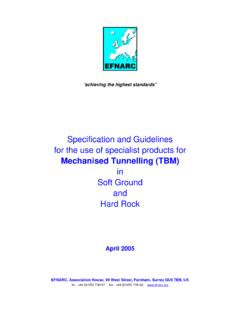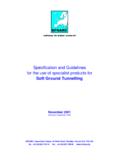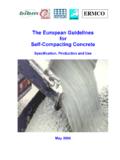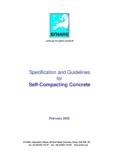Transcription of Specification and Guidelines on Thin Spray-on Liners for ...
1 'achieving the highest standards' Specification and Guidelines on thin Spray-on Liners for mining and tunnelling July 2008 EFNARC The Technical Committee on thin Spray-on Liners was formed in 2004 with the objective of producing a Specification and Guidelines for their use for non-structural rock support in the mining and tunnelling Industry. All comments on this Specification and Guidelines should be submitted to the EFNARC secretary: Acknowledgements EFNARC wishes to gratefully acknowledge the work undertaken by the members of its thin Spray-on Liners Technical Committee and the contributions made by internationally recognised experts in the preparation of this document. Although care has been taken to ensure, to the best of our knowledge that all data and information contained herein is accurate to the extent that it relates to either matters of fact or accepted practice or matters of opinion at the time of publication, EFNARC assumes no responsibility for any errors in or misrepresentation of such data and/or information or any loss or damage arising from or related to its use.
2 All rights reserved. No part of this publication may be reproduced, stored in a retrieval system or transmitted, in any form or by any means, electronic, mechanical, recording or otherwise, without prior permission of EFNARC. 2008 EFNARC CONTENTS 1. Scope .. 1 2. Introduction .. 1 3. Fields of Application .. 1 4. Referenced Standards .. 2 5. Definitions .. 2 6. Product Requirements .. 3 7. Exchange of Information and Time Schedule .. 4 8. Materials .. 5 9. Design .. 5 10. Preparation of Substrate .. 6 11. Work on Site .. 6 12. Health and Safety Precautions .. 9 13. Inspection and Testing of Work .. 10 A1. TSL Linear Block Support Test .. 11 A2. Future Developments .. 18 Specification and Guidelines on thin Spray-on Liners for mining and tunnelling ENC 250 TSL 25-07-08 1 1 SCOPE This document provides a Specification and Guidelines dealing with thin Spray-on Liners (TSLs) used in the mining and tunnelling Industries for non-structural rock support and for sealing rock against gas and moisture transfer and weathering.
3 Whilst the primary support is provided by steel anchors and/or arches and/or reinforced shotcrete, the TSL provides an initial stabilising layer which will contribute to the overall support. 2 INTRODUCTION This Specification provides minimum standards of performance and methods of application for thin Spray-on Liners (TSLs) used in the mining and tunnelling industries. TSLs have by convention been classified as either reactive or non-reactive systems (see ). These Guidelines principally deal with the market leading non-reactive Class S (see 3) TSLs based on cementitious polymer-modified systems that cure by water loss from the polymer emulsion allowing the polymer film to form and gain strength. As the end product is essentially a polymer filled with cement it retains many of the characteristics associated with polymer systems such as good flexibility, high tensile strength and high elongation at break. The coating also provides a barrier against gas and moisture movement.
4 Other materials may be used provided they satisfy the performance and safety requirements given in Table 1. The main advantages of TSLs when compared with shotcrete include the following: a) thinner applied thickness easier materials handling b) increased toughness, durability, resilience, and resistance to impact c) stronger permanent bond to the substrate d) reduced dusting e) much greater tolerance to ground movement and resistance to cracking. Although many tests have been proposed for the measurement of the load bearing capacity of TSLs these have been very difficult to interpret and produced inconsistent results. A linear block support test has thus been developed (appendix 1) which gives an indication of the load bearing capacity of the TSL in terms of the mass of the largest block which can be supported. TSLs can be applied either before or after the primary support provided operators do not work under unsupported ground.
5 3 FIELDS OF APPLICATION TSLs can be divided into two1 classes depending on their end use: (i) Class B - basic: principally used as an anti-weathering coating (ii) Class S - standard: used to permanently stabilise the integrity of rock structures whilst accommodating the stresses associated with strata movement, as an anti- weathering coating, mesh replacement, moisture and gas barrier. 1 It is possible that up to two additional classes will be added in the future, these are discussed in Appendix 2 Specification and Guidelines on thin Spray-on Liners for mining and tunnelling ENC 250 TSL 25-07-08 2 4 REFERENCED STANDARDS The following standards are referred to in the Specification . However, any subsequently published or revised European Standard (EN) should always take preference over standards referred to herein. The hierarchy of authority is EN standard, ISO standard, National standard, ASTM.
6 Tensile Strength: DIN 53504 Type S2 or ASTM D638 Bond strength: EN 1542 pull-off test using reference concrete EN 1766 (type MC ) as substrate. A 50mm dolly is preferred. Shear strength: DIN EN 1373 or ASTM D732 Flammability: EN 13823 The Single Burning Item (SBI) test ASTM E84 surface spread of flame. 3-4mm thick layer applied to EN1766 concrete slab. Products of combustion: NES 713 Supplemental tests: a) Tear strength ASTM D624 b) Permeability to water vapour, methane, radon etc DIN 52615, DIN 16726, SN 021582 c) Crack bridging DIN EN 1062-7 Water quality EN1008 Shore A hardness BS EN ISO 868:2003 Water tightness EN 1928 or DIN 16726 Freeze thaw resistance SN 73 1326 or SS 13 72 44 5 DEFINITIONS liner A continuous membrane applied to strata to provide a means of non-structural surface reinforcement. thin Applied thickness typically less than 10mm. Wet spray Pumping liquid(s) to a nozzle and applying to a substrate by spraying.
7 Dry spray Supply of a dry blended product to a nozzle with compressed air and mixing with liquid within the nozzle and applying to a substrate. Reactive/non-reactive systems TSLs are classified as either reactive or non-reactive depending on their film formation/curing mechanism. Reactive systems rely on the cross linking of polymers ( epoxy, polyurethane, methyl methacrylate etc) whereas non-reactive systems are cement/water/polymer systems which rely on the removal of water from the system for the polymer to film form. Specification and Guidelines on thin Spray-on Liners for mining and tunnelling ENC 250 TSL 25-07-08 3 6 PRODUCT REQUIREMENTS Performance requirements General and Special requirements are summarised in Table 1. The requirements shall be based on tests undertaken under laboratory conditions at 21 2 C and 60 10% rh. Unless otherwise stated, all results are for 3-4mm thick specimens after 28 days cure.
8 Table 1: Performance requirements Performance characteristic Specified test method Class B Class S A Tensile strength DIN 53504 Type S2 or ASTM D638 > 2 MPa at 7 days B Rate of strength development: (Time to reach a Tensile Strength of 2 MPa at 50 5% rh and 80 5% rh at 23oC) DIN 53504 Type S2 or ASTM D638 < 7 days at 50 5% rh < 14 days at 80 5% rh A Linear load resistance TSL Linear Block Support Test (Appendix 1) >5kN/m (equivalent to a 2 tonne block - DSK2 requirement) A Tensile E-modulus Stress/strain on DIN 53504 Type S2 or ASTM D638 specimens < A Elongation at break DIN 53504 Type S2 or ASTM D638 >10% A Shear strength EN 1373 or ASTM D732 on sawn granite. > at 24 hours A Ultimate bond strength EN 1542 to EN 1766 (type MC ) concrete grit blasted to SA 2 Bonds to host rock >1 MPa A Fire classification EN 13823 under conditions of EN 13501-1:2002 Reaction to fire behaviour B or better.
9 Smoke index s1. Flaming particles/droplets d0 Reaction to fire behaviour B or better. Smoke index s1. Flaming particles/droplets d0 A Flammability ASTM E84 (surface spread of flame and smoke index development) Class 1 Class 1 A Products of combustion NES 713 Pass as suitable for underground use Pass as suitable for underground use B Crack bridging DIN EN 1062-7 >1mm B Tear strength @ 28 days DIN ISO 34-1 DIN 53515 >20N/mm B Water tightness EN 1928 or DIN 1048 No water leakage after 28 days at 7 bar B Freeze thaw resistance SN 73 1326 or SS 13 72 44 >50 cycles B Permeability to water vapour, methane, radon etc DIN 52615, DIN 16726 or SN 021582 Water vapour < m/s Methane < m/s Radon < B Surface Electrical resistance DIN 22107 Part 6 <109 /cm <109 /cm B Electrostatic charge transfer EN 13463 Part 1 It must not be possible to charge the TSL It must not be possible to charge the TSL 2 DSK Deutsche Steinkohle (German Coal Mines)
10 Specification and Guidelines on thin Spray-on Liners for mining and tunnelling ENC 250 TSL 25-07-08 4 Classifications for intended use: A - Mandatory requirement for all intended uses - standard test method and performance limits are specified. B - Special requirement for particular situations - standard test method is specified and performance limits are to be met or the result declared on request. Polymer cement based TSLs are expected to have good long term durability due to saturated polymers being used and the long term stability of inorganic cements. In most applications in mines and tunnels TSLs are not exposed to sunlight. Declaration of Conformity Testing Initial type testing shall be carried out by the manufacturer to prove the conformity of each product covered by this Specification , with the requirements of Table 1. Quality control system (or Factory production control system) The manufacturer shall operate a quality control system in accordance with the principles of EN ISO 9000 at each facility where products covered by this Specification are produced.









